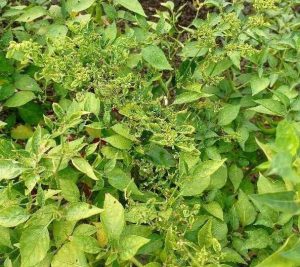
Disease symptoms:
Bacterial wilt is a disease of the vascular tissue. When a plant is infected, E. tracheiphila multiplies within the xylem, eventually causing mechanical blockage of the water transport system. The first sign of infection, which appears about five days after acquisition, is the wilting of individual leaves on a single stem. However, the disease will soon spread down the runner and then infect the whole plant, causing it to shrivel and die. There is a diagnostic test for bacterial wilt that can be done in the field. The presence of the E. tracheiphila causes the sap to become a milky colour and acquire a sticky consistency. If the stem is cut near the crown and the ends are slowly pulled apart, the sap should form a viscous string.
Bacterial wilts of tomato, Capsicum (pepper), Solanum ovigerum Brinjal, Tobacco, Cucurbits, and potato can be caused by (Burkholderiaceae) Ralstonia solanacearum.
The symptoms of bacterial wilt infection can be seen on all parts of infected plants.
Survival and spread:
Bacterial wilt pathogen can survive in soil (without a host for several seasons), water, seed tubers, potato plant remnants.
The disease can spread from field to field or from plant to plant within field via infected seed, air, water, soil, farming tools, livestock and people.
Favourable conditions:
High temperature, soil moisture, low pH.
The disease spread rapidly in the warmer temperatures in storage areas. Infected seed can also be a source of the disease in the field.
Controls:
Once a plant is infected, there is no way of stopping the spread of the disease. Some cucurbit cultivars are less susceptible than others, so it is beneficial to plant these cultivars. However, since wilt-resistant plants have not yet been developed, the most effective way to prevent the disease is to keep beetle populations at a minimum. While various methods of beetle control have been tested, the most effective preventative measure is to keep beetle populations as low as possible through careful field monitoring and insecticide sprays. Cultural control can also be effective.
Carbaryl, Malathion, or rotenone insecticides or combination products are registered to treat beetles.
They will provide control of the beetles if applied when beetles first appear in the spring.
Early control, beginning as soon as the plants emerge, is most important as a single beetle can introduce the bacteria. One to four generations of the beetle may occur on unprotected plants and applications of these insecticides at weekly intervals may become necessary.





